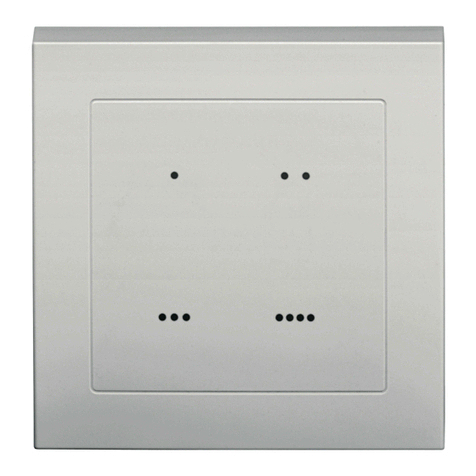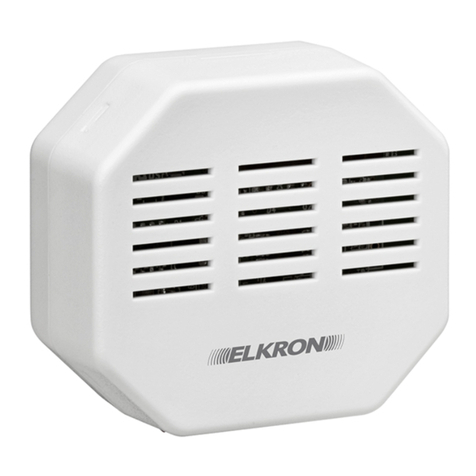
Modalità di montaggio
Esistono due modi per montare il contatto: con biadesivo o con viti.
Montaggio con biadesivo (solo in casi eccezionali)
I. Pulire la superficie utilizzando uno sgrassatore idoneo.
II. In base al lato di montaggio, rimuovere la pellicola di protezione da uno dei lati
del biadesivo e farlo aderire saldamente al retro del dispositivo.
III. Rimuovere l’altra pellicola di protezione e far aderire saldamente il contatto nella
posizione desiderata.
<
<N
NO
OT
TA
A>
>
Non utilizzare la modalità di montaggio con biadesivo su superfici con vernice scrostata
o crepata, o su superfici irregolari.
Installare il contatto sull’oggetto fermo (come il telaio di una porta o di una finestra) e
montare il magnete sull'oggetto mobile (come una porta o una finestra). Verificare con
cura che non sia stato smarrito il cappuccio in gomma montato sull’interruttore
tamper.
Montaggio con viti
La base presenta due predisposizioni per i fori, dove la plastica è più sottile, da utilizzare
per il montaggio.
Per montare il contatto:
I. Rimuovere il coperchio svitando le viti di sicurezza.
II. Rompere la predisposizione sulla base.
III. Utilizzando la dima per i fori, praticare i due fori sul muro.
IV. Inserire i tasselli se si esegue il fissaggio su intonaco o mattoni.
V. Avvitare la base ai tasselli.
VI. Fissare il coperchio sulla base e serrare le viti di fissaggio coperchio. Verificare con
cura che non sia stato smarrito il cappuccio in gomma montato sul tamper.
DICHIARAZIONE DI CONFORMITÀ UE SEMPLIFICATA
Il fabbricante, URMET S.p.A., dichiara che il tipo di apparecchiatura radio: CONTATTO MAGNETICO MINI DC600 – DC600/BR
è conforme alla direttiva 2014/53/UE. Il testo completo della dichiarazione di conformità UE è disponibile al seguente indirizzo
Internet: www.elkron.com.
CLICCARE SUL SEGUENTE LINK DEL SITO ELKRON PER ACCEDERE ALLA SCHEDA TECNICA DEL PRODOTTO E
SCARICARE IL MANUALE COMPLETO:
DIRETTIVA 2012/19/UE DEL PARLAMENTO EUROPEO E DEL CONSIGLIO del 4 luglio 2012 sui rifiuti di apparecchiature
elettriche ed elettroniche (RAEE).
Il simbolo del cassonetto barrato riportato sull’apparecchiatura o sulla sua confezione indica che il prodotto alla fine
della propria vita utile deve essere raccolto separatamente dagli altri rifiuti.
L’utente dovrà, pertanto, conferire l’apparecchiatura giunta a fine vita agli idonei centri comunali di raccolta differenziata
dei rifiuti elettrotecnici ed elettronici. In alternativa alla gestione autonoma è possibile consegnare l’apparecchiatura che
si desidera smaltire al rivenditore, al momento dell’acquisto di una nuova apparecchiatura di tipo equivalente.
Presso i rivenditori di prodotti elettronici con superficie di vendita di almeno 400 m2 è inoltre possibile consegnare gratuitamente,
senza obbligo di acquisto, i prodotti elettronici da smaltire con dimensione massima inferiore a 25 cm.
L’adeguata raccolta differenziata per l’avvio successivo dell’apparecchiatura dismessa al riciclaggio, al trattamento e allo
smaltimento ambientalmente compatibile contribuisce ad evitare possibili effetti negativi sull’ambiente e sulla salute e favorisce il
reimpiego e/o riciclo dei materiali di cui è composta l’apparecchiatura.
ELKRON
Tel. +39 011.3986711 - Fax +39 011.3986703
ELKRON è un marchio commerciale di URMET S.p.A.
Via Bologna 188/C – 10154 Torino (TO) Italia
HU
www.urmet.com
U
H
Predisposizioni
Telaio




























